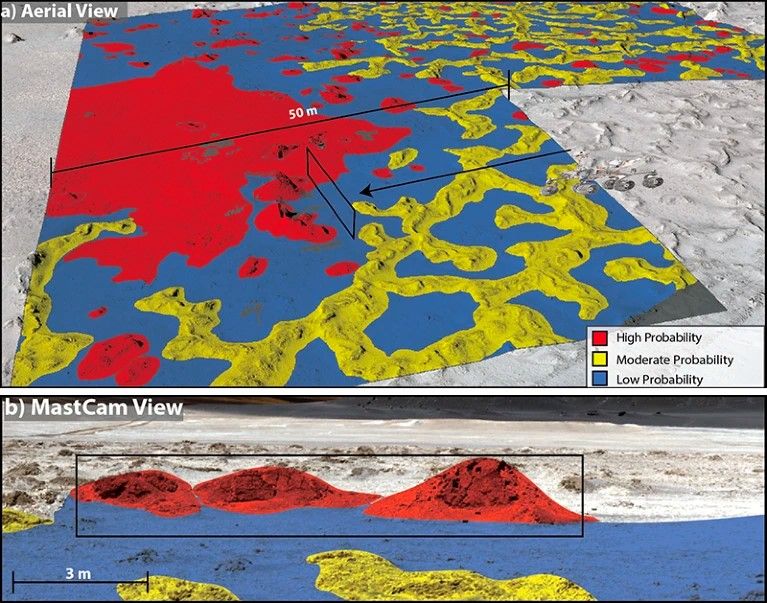New study shows artificial intelligence could help locate life on Mars
Thursday 16th Mar 2023, 3.11pm
Our process combined statistical microbial ecology surveys, remote sensing from unmanned aerial vehicles, and machine learning to map, model, and predict the distribution of biosignatures in a Mars-relevant setting. The approach may also have applications for other astrobiology targets, such as the surface of Titan, the plumes of Enceladus, or the ice cover of Europa.
Dr Freddie Kalaitzis, Department of Computer Science, University of Oxford.
In the search for life beyond Earth, researchers have few opportunities to collect samples from Mars or elsewhere. This makes it critical that these missions target locations that have the best chance of harbouring life. In this new study, researchers demonstrated that artificial intelligence (AI) and machine learning methods can support this by identifying hidden patterns within geographical data that could indicate the presence of life.
Led by Dr Kimberley Warren-Rhodes at the SETI Institute and involving an international team of over 50 researchers, the first part of the study was an ecological survey of a 3 km² area in the Salar de Pajonales basin, at the boundary of the Chilean Atacama Desert and Altiplano in South America. This mapped the distribution of photosynthetic microorganisms and used techniques such as gene sequencing and infrared spectroscopy to reveal distinct markers of life, called ‘biosignatures.’ These data were then combined with aerial images captured by drones to train a machine learning model to predict which macro- and microhabitat types would be associated with biosignatures that could indicate life.
When tested using data on which it was not trained, the resulting model was capable of locating and detecting biosignatures up to 87.5% of the time (versus ≤10% by randomly searching). This decreased the search area required to find a positive result by up to 97%. Ultimately, similar models could be used to guide rovers exploring planets to the locations most likely to contain signs of life.
Dr Freddie Kalaitzis from the University of Oxford’s Department of Computer Science led the application of machine learning methods to microhabitat data. He said: ‘This work demonstrates an AI-guided protocol for searching for life on a Mars-like terrestrial analogue on Earth. This protocol is the first of its kind trained on actual field data, and its application can in principle generalise to other extreme life-harbouring environments. Our next steps will be to test this method further on Earth with the aim that it will eventually aid our exploration for biosignatures elsewhere in the solar system, such as Mars, Titan and Europa.’
The Pajonales, a four-million-year-old lakebed, is one of the closest analogues to the Martian environment on Earth, and considered inhospitable to most forms of life. The high altitude (3,541 m) basin experiences exceptionally strong levels of ultraviolet radiation, hypersalinity and low temperatures – akin to the evaporitic basins of Mars.
 Aerial view (above) and ground view (below) from a rover of a biosignature probability map of the same area. Image credit: M. Phillips, K. A. Warren-Rhodes & F. Kalaitzis.
Aerial view (above) and ground view (below) from a rover of a biosignature probability map of the same area. Image credit: M. Phillips, K. A. Warren-Rhodes & F. Kalaitzis.For the ecological survey, the researchers collected over 7,700 images and 1,150 samples, and used a variety of instruments to test for the presence of photosynthetic microbes living within the salt domes, rocks, and alabaster crystals that make up the basin’s surface. Biosignature markers included carotenoid and chlorophyll pigments, which could be seen as orange-pink and green layers respectively.
 Dr Freddie Kalaitzis, Department of Computer Science. Image credit: Freddie Kalaitzis.
Dr Freddie Kalaitzis, Department of Computer Science. Image credit: Freddie Kalaitzis.
The images recorded by the drones were combined with ground sampling data and 3D topographical mapping to classify regions into four macrohabitats (metre to kilometre scales) and six microhabitats (centimetre scale). Statistical analysis found that the microbial organisms across the study site were not distributed randomly, but clustered in distinct regions – despite the Pajonales having a near-uniform mineral composition. Follow-up experiments revealed that water availability is likely to be the crucial factor determining the position of these biological hotspots, rather than other environmental variables such as nutrient or light availability.
The combined dataset was used to train convolutional neural networks to predict which macro- and microhabitats were most strongly associated with biosignatures. ‘For both the aerial images and ground-based centimetre-scale data, the model demonstrated high predictive capability for the presence of geological materials strongly likely to contain biosignatures’ said Dr Kalaitzis. ‘The results aligned well with ground-truth data, with the distribution of biosignatures being strongly associated with hydrological features.’
The research team now intend to test the model’s ability to predict the location of similar yet different natural systems in the Pajonales basin, such as ancient stromatolite fossils. Going further, the model will be used to map other harsh ecosystems, including hot springs and permafrost soils. In time, the data from these studies will help inform and test hypotheses on the mechanisms that living organisms use to survive in extreme environments.
‘Our study has once again demonstrated the power of machine learning methods to accelerate scientific discovery through its ability to analyse immense volumes of different data and identify patterns that would be indiscernible to a human being’ Dr Kalaitzis added. ‘Ultimately, we hope the approach will facilitate compilation of a databank of biosignature probability and habitability algorithms, roadmaps, and models that can serve as a guide for exploration on Mars.’
The paper ‘Orbit-to-Ground Framework to Decode and Predict Biosignature Patterns in Terrestrial Analogues’ has been published in Nature Astronomy.
The SETI Institute is a non-profit, multi-disciplinary research and education organization whose mission is to explore, understand, and explain the origin and nature of life in the universe and the evolution of intelligence.

